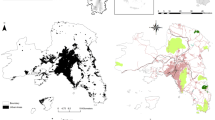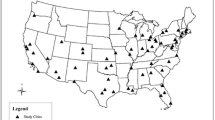Abstract
Issues of growth, especially the spatial nature of recent urban development and its implications for travel patterns, have received a great deal of attention. In particular, questions persist as to how the spatial distribution of workers and jobs influences commute patterns. This paper investigates changes in commuting and land use patterns using measures of jobs–housing balance, commuting efficiency and other statistics. A smaller urban area is chosen for study (Tallahassee, FL, USA)and data on its workers, jobs, and commute patterns are obtained from the Census Transportation Planning Package for 1990 and 2000. The key research questions investigated probe whether there were substantial changes in urban form and commuting over the period. A two-tiered approach is taken where change is explored at the regional and local scales using GIS, optimization procedures, and inferential statistical techniques. The results reveal the extent of the spatial changes in the study area between 1990 and 2000. Major findings included stability in urban structure over the time period, as well as a persistent strong relationship between land use and commute patterns. These results are discussed in light of their implications for other cities and for future work.
Similar content being viewed by others
References
Abbott C (1997) The Portland region: where city and suburbs talk to each other – and often agree. Housing Policy Debate 8(1):11–51
Anas A, Arnott R, Small KA (1998) Urban spatial structure. J Econ Lit 36(3):1426–1464
Black WR (1996) Sustainable transportation: a US perspective. J Transp Geogr 4(3):151–159
Breheny M (1997) Urban compaction: feasible and acceptable?. Cities 14(4):209–217
Buliung RN, Kanaroglou PS (2002) Commute minimization in the greater Toronto area: applying a modified excess commute. J Transp Geogr 10(3):177
Cervero R (1989) Jobs–housing balancing and regional mobility. J Am Plann Assoc 55(2):136–150
Crane R (1996) The influence of uncertain job location on urban form and the journey to work. J Urban Econ 39(3):342–356
Ewing R (1995) Beyond density, mode choice, and single purpose trips. Transp Q 49(4):15–24
Fernandez RM (1994) Race, space, and job accessibility – evidence from a plant relocation. Econ Geogr 70(4):390–416
Freeman L (2001) The effects of sprawl on neighborhood social ties – an explanatory analysis. J Am Plann Assoc 67(1):69–77
Giuliano G, Small KA (1993) Is the journey to work explained by urban structure. Urban Stud 30(9):1485–1500
Goodchild MF, Anselin L, Deichmann U (1993) A framework for the areal interpolation of socioeconomic data. Environ Plann A 25(3):383–397
Gordon P, Richardson HW (1996) Beyond polycentricity – the dispersed metropolis, Los Angeles, 1970–1990. J Am Plann Assoc 62(3):289–295
Hamilton BW (1989) Wasteful commuting again. J Polit Econ 97(6):1497–1504
Handy S (2005) Smart growth and the transportation – land use connection: what does the research tell us? Int Reg Sci Rev 28(2):146–167
Horner MW (2002) Extensions to the concept of excess commuting. Environ Plann A 34(3):543–566
Horner MW (2004a) Exploring metropolitan accessibility and urban structure. Urban Geogr 25(3):264–284
Horner MW (2004b) Spatial dimensions of urban commuting: a review of major issues and their implications for future geographic research. Prof Geogr 56(2):160–173
Hunt JD, Kriger DS, Miller EJ (2005) Current operational urban land-use-transport modelling frameworks: a review. Transport Rev 25(3):329–376
Jun MJ (2004) The effects of Portland’s urban growth boundary on urban development patterns and commuting. Urban Stud 41(7):1333–1348
Krizek K, Levinson D (2005) Teaching integrated land use–transportation planning – topics, readings, and strategies. J Plan Educ Res 24(3):304–316
Levine J (1998) Rethinking accessibility and jobs–housing balance. J Am Plann Assoc 64(2):133–149
Levinson DM (1998) Accessibility and the journey to work. J Transp Geogr 6(1):11
Lucy WH, Phillips DL (1997) The post-suburban era comes to Richmond: city decline, suburban transition, and exurban growth. Landsc Urban Plan 36(4):259–275
Merriman D, Ohkawara T, Suzuki T (1995) Excess commuting in the Tokyo Metropolitan-Area – measurement and policy simulations. Urban Stud 32(1):69–85
Miller HJ, Shaw S-L (2001) Geographic information systems for transportation. Oxford University Press, New York
O’Kelly ME, Lee W (2005) Disaggregate journey-to-work data: implications for excess commuting and jobs–housing balance. Environ Plann A 37(12):2233–2252
Peng ZR (1997) The jobs–housing balance and urban commuting. Urban Stud 34(8):1215–1235
Redmond LS, Mokhtarian PL (2001) The positive utility of the commute: modeling ideal commute time and relative desired commute amount. Transportation 28(2):179–205
Rodríguez DA (2004) Spatial choices and excess commuting: a case study of bank tellers in Bogotá, Colombia. J Transp Geogr 12(1):49–61
Rouwendal J, Nijkamp P (2004) Living in two worlds: a review of home-to-work decisions. Growth Change 35(3):287–303
Schwanen T, Dieleman FM, Dijst M (2004a) The impact of metropolitan structure on commute behavior in the Netherlands: a multilevel approach. Growth Change 35(3):304–333
Schwanen T, Dijst M, Dieleman FM (2004b) Policies for urban form and their impact on travel: the Netherlands experience. Urban Stud 41(3):579–603
Scott DM, Kanaroglou PS, Anderson WP (1997) Impacts of commuting efficiency on congestion and emissions: case of the Hamilton CMA, Canada. Transp Res D Transp Environ 2(4):245–257
Song Y (2005) Smart growth and urban development pattern: a comparative study. Int Reg Sci Rev 28(2):239–265
Song Y, Knaap GJ (2004) Measuring urban form – is Portland winning the war on sprawl? J Am Plann Assoc 70(2):210–225
Sultana S (2002) Job/housing imbalance and commuting time in the Atlanta metropolitan area: exploration of causes of longer commuting time. Urban Geogr 23(8):728–749
Tsai YH (2005) Quantifying urban form: compactness versus ‘sprawl’. Urban Stud 42(1):141–161
Wang FH (2000) Modeling commuting patterns in Chicago, in a GIS environment: a job accessibility perspective. Prof Geogr 52(1):120–133
Wang FH (2003) Job proximity and accessibility for workers of various wage groups. Urban Geogr 24(3):253–271
White MJ (1988) Urban commuting journeys are not wasteful. J Polit Econ 96(5):1097–1110
Wong DW (2005) Formulating a general spatial segregation measure. Prof Geogr 57(2):285–294
Author information
Authors and Affiliations
Corresponding author
Rights and permissions
About this article
Cite this article
Horner, M.W. A multi-scale analysis of urban form and commuting change in a small metropolitan area (1990–2000). Ann Reg Sci 41, 315–332 (2007). https://doi.org/10.1007/s00168-006-0098-y
Received:
Accepted:
Published:
Issue Date:
DOI: https://doi.org/10.1007/s00168-006-0098-y




